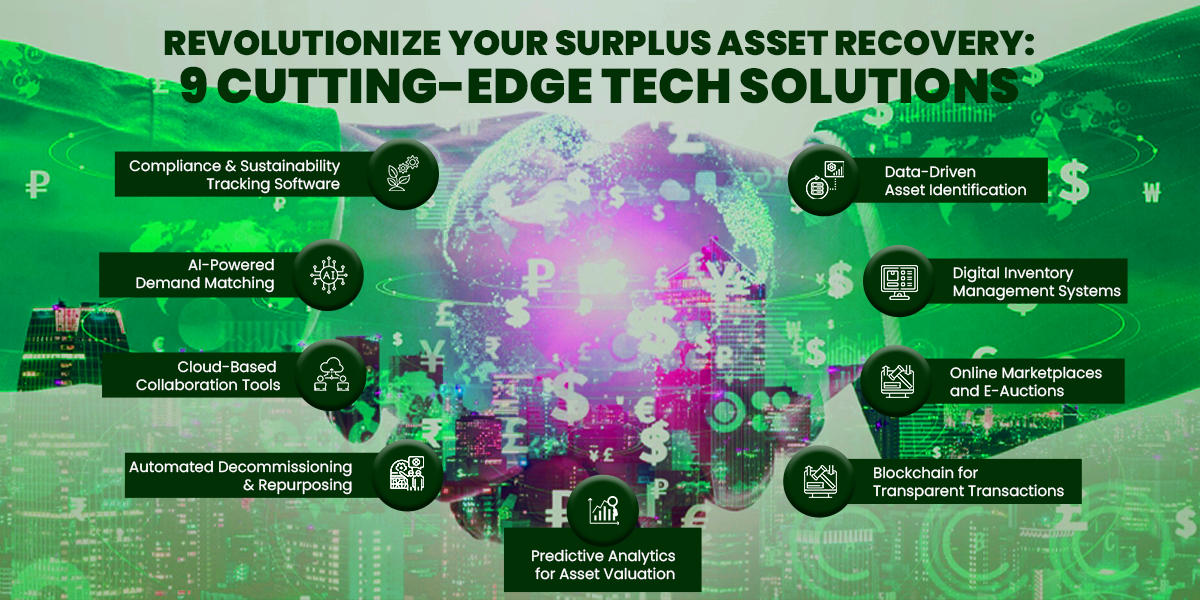
9 Tech-Driven Strategies to Boost Your Surplus Asset Recovery
Surplus Asset Recovery is beneficial to all types of businesses. Every business has an array of unused assets lying around that can range from older pieces of equipment, unused inventory, and even old technological gadgets. These business assets aren’t managed properly and can take up a significant amount of space which will ultimately lead to financial loss. Selling, repurposing, or even recycling unused assets can ensure a business does not go to waste.
The advancements in technology have ensured that asset recovery is more profitable than ever before. There is a drastic shift in the way people manage surplus assets, from AI-powered tracking systems to blockchain-based transactions. Using modern tools makes the process efficient.
In this post, we will explore nine tech-driven strategies that will ensure businesses recover more value, improve operational efficiency, and cut down on waste. These strategies, whether for a small business or large corporation, will make sure that no asset goes unused. Ready? Let’s go.
Revolutionize Your Surplus Asset Recovery: 9 Cutting-Edge Tech Solutions
Technology is changing the landscape and making surplus asset recovery management orders of magnitude easier, more efficient, and more profitable. The use of modern digital technologies enables firms to improve the tracking of their assets, increase the resale value of the assets, and ensure compliance with sustainability policies. The time has come for you to consider these nine technology-oriented methods that can change your surplus asset recovery approach for the better:
- Data-Driven Asset Identification
- Digital Inventory Management Systems
- Online Marketplaces and E-Auctions
- Blockchain for Transparent Transactions
- Predictive Analytics for Asset Valuation
- Automated Decommissioning and Repurposing
- Cloud-Based Collaboration Tools
- AI-Powered Demand Matching
- Compliance and Sustainability Tracking Software
Data-Driven Asset Identification
Identifying surplus assets and adding maximum recovery value is crucial for businesses. Combining AI with data analytics radically changes the asset management process, as compared to traditional tracking techniques. Now, businesses can rely on real-time AI tracking which allows them to monitor asset location and condition instantly, Improving the efficiency of automated categorization of items by machine learning algorithms based on their value and potential resale value. Precise tracking of items using inventory tagging like RFID tags or QR codes further reduces losses. Businesses can make more informed decisions with insightful visibility when different asset data is integrated. Predictive analytics further enhance asset valuation by helping businesses develop and optimize recovery strategies.
Digital Inventory Management Systems
Surplus asset recovery is greatly enhanced with the application of a digital inventory management system. Technology today can assist a business in efficiently tracking, organizing, and managing surplus assets through these systems. Businesses can remotely access their inventory data on the cloud which makes control over their assets from any location seamless. These systems are also improved by the inclusion of IoT devices which serve to monitor asset usage, location, and condition automatically. Automated stock changes and real-time tracking enhance business efficiency. In addition, digital inventory systems protect sensitive data through stored cloud information while still giving important surplus asset insights. These systems not only improve operational efficiency but also ensure businesses get the maximum recovery value for unused assets.
Online Marketplaces and E-Auctions
Online marketplaces and e-auctions have changed surplus asset recovery by enabling businesses to sell unused assets more quickly and efficiently. These platforms advertise unused items, making it easy for buyers and sellers to connect. Businesses now have access to B2B and B2C platforms, which expands their reach and increases the likelihood of getting better prices for surplus items. These platforms utilize sophisticated AI algorithms that assist in setting pricing according to the market and historical data. Moreover, demand forecasting tools predict the optimum time to sell assets to maximize return on investment. Online marketplaces and e-auctions have made it easier for businesses to recover surplus assets and maximize profit at the same time.
Blockchain for Transparent Transactions
Surplus asset recovery is now being changed by blockchain technology due to the transactions being secure and transparent. It builds a digital ledger in which every transaction is captured and validated which makes it almost impossible to change anything. This transparency guarantees that both buyers and sellers are well informed, thereby creating trust between them. Through blockchain, businesses can secure their records, minimize the chances of fraud, and enhance accountability. Stakeholders are more confident with the recoverable assets due to the available deal history. Companies should incorporate blockchain technology for better security and effectiveness in sustainable asset management.

Predictive Analytics for Asset Valuation
Predictive analytics readjusts how organizations evaluate the worth of surplus assets. Through machine learning, companies can predict the depreciation and resale value of an asset with great accuracy based on its historical data, market trends, and conditions. Such decisions are reasoned and help managers optimize sales or reallocation for better returns. Predictive analytics also enables businesses to recognize patterns in demand for their assets, thereby assisting in selling at the most optimal times. This not only increases revenue but decreases costs associated with holding assets, enhancing the efficiency and profitability of surplus asset recovery.
Automated Decommissioning and Repurposing
Automated decommissioning and repurposing are changing how businesses manage their surplus asset management. Robotics and automation make active dismantling, refurbishing, and repurposing of assets easier and more precise. Complex machinery can be safely disassembled, valuable components can be recovered, and further refined or prepared for resale. This method saves manual work and is more efficient in waste management. Also, technology-powered upcycling allows old assets to be renewed alongside other environmental initiatives. With automated decommissioning and repurposing, businesses improve operational efficiency and reduce disposal expenses.
Cloud-Based Collaboration Tools
The importance of cloud-based collaboration tools in the communication and coordination of different departments improves surplus asset recovery. Teams can access real-time data at any location, enabling sharing of information, updating asset statuses, and tracking recovery processes. Having access to documents and data allows businesses to make decisions faster and eliminates miscommunication. The collaboration between internal and external partners can now be done using cloud platforms guaranteeing that all parties follow the same progress. Companies can enhance surplus management, reduce delays, and improve recovery efficiency by using cloud-based collaboration tools.
AI-Powered Demand Matching
Operators of any business understand the complexities that come with handling asset surplus like paying attention to demand forecasts and potential buyers. Thankfully, that is now automated with demand-matching AI. AI has gone as far as analyzing a buyer’s history, preferences, and even pricing trends to recommend options that would best satisfy an asset’s maximum value. Businesses find it easier to locate ideal buyers in shorter durations of time, thus minimizing the amount of time assets are sitting idle. In addition, AI can customize marketing campaigns directed toward buyers by predicting their needs based on prior spending habits. Adopting AI in demand matching systems for companies will automate sales, create efficiency in asset turnover, and improve overall recovery efficiency, which can be greatly beneficial.
Compliance and Sustainability Tracking Software
Compliance and sustainability tracking tools greatly assist businesses in recovering surplus assets by helping them adhere to environmental policies. These software tools mitigate legal risk by ensuring business processes concerning asset disposal are compliant with relevant laws. They also measure the positive environmental impacts of surplus asset recovery, such as carbon emissions and waste reduction. These businesses can be confident in their sustainability efforts because detailed digital reports capture the asset disposal process. The compliance and sustainability tracking tools help these businesses save the planet while improving their social responsibility reputation.
Conclusion
With the latest technology integrated within businesses, they can now handle surplus asset recovery quicker, easier, and more profitably than before. Companies can now track, sell, and repurpose their assets using advanced technologies such as AI, data analytics, and blockchain. Not only do these tech-driven solutions assist in recovering lost value, but they also decrease waste while promoting sustainability.
Incorporating the right technology in any business can help repair long-term financial damage, reducing operational costs, and practicing better resource control all at the same time. In the long run, these businesses will contribute to improving the environment and maintaining relevance in a competitive market.
Reevaluating how surplus assets are managed needs to be done now. Instead, these nine strategies should be employed so that value can be maximized, efficiency improved, and asset waste can be eliminated. Take the first step today and watch the asset recovery process improve tremendously.



